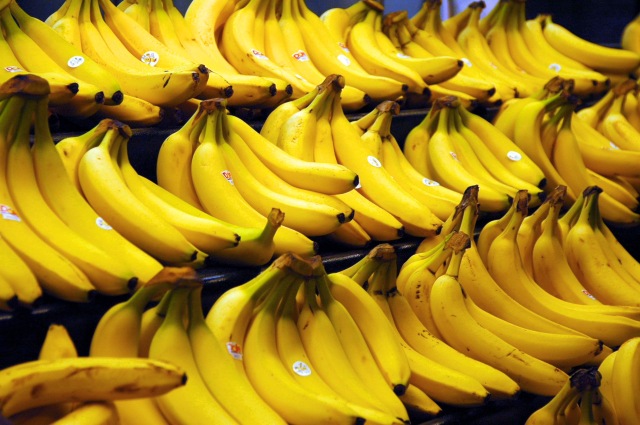
With over 140 million tonnes produced every year (FAOStat), bananas are the fourth most cultivated fruit (technically a berry) on the planet. When most Americans think of a “banana” — nine iches, yellow, shaped like a boomerang (of course a boomerang, ¿what else?)– they’re thinking of the Cavendish. But, the Cavendish is only one of more than a thousand cultivars of two wild species, Musu acuminata and Musa balbisiana. The variety of bananas (and the genetically similar plantain) is mind-boggling, ranging in colour from bright red to darkest brown, from just a few inches to over a 18, and every taste, tang, and consistency imaginable. There are even bananas with seeds so dense they can chip a tooth.
By far, the Cavendish is the most cultivated banana variety on the planet. Exploding in popularity in the 1960s, this variety represents 99% of the banana export market. Due to its thick protective rind and slow ripening process, the Cavendish is almost uniquely designed for export from the warm equatorial countries where the banana thrives.

Big Mike and His Long Reach
Back at the turn of the 19th century, however, the Cavendish was merely a curiosity in a British hothouse, obscure and unknown. The unopposed king of the banana Empire in the late 1800s and into the new century was the Gros Michel (‘Big Mike’). A shorter, but much sweeter, smoother, and, by many accounts, far superior banana to its slender cousin.
The Gros Michel was so tasty, that between 1900, when United Fruit (later renamed Chiquita) introduced it and 1910, US consumption rose from 15 million to over 40 million bunches a year. Gros Michel built United Fruit into such a powerhouse, they become a major force of governmental and industrial influence throughout Central and South America. The term Banana Republic was, in part, coined as a description of the Honduran plutocracy surrounding the banana industry.

The Cavendish Dervish
The might of the Gros Michel hits its heyday in the mid 1920s and dwindled into death and obscurity by the 1950s. No, it wasn’t fickle American stomachs or stricter wage laws, it was the fungal pathogen Fusarium oxysporum or, more commonly, Panama Disease.
Panama Disease is a highly invasive, strangely resilient plant disease which feasted on the Gros Michel. Through a mechanism not entirely understood by even modern scientists, the fungus gums up the cells and internal pathways of the plant, leading to slow dehydration and internal rot. Panama ignores most herbicides and can live dormant in soil for decades, making it easy to trek from field to field, or even country to country through muddy boots, shared farm equipment, or poorly cleaned transplants. In a short 30 years, Panama wiped out over 100,000 acres of Gros Michel and cost the industry nearly $2.3 billion. The Gros Michel become functionally extinct, with the banana industry near to follow.
Into the suddenly empty ring stepped the Cavendish. Though less resilient to other diseases, and unpardonably less sweet to gourmets, the Cavendish happily withstood Panama. Standard Fruit (later, Dole) introduced the Cavendish and soon eclipsed United Fruit as the industrial banana powerhouse. Fast forward to Today, and the Cavendish banana is so popular in the US, it outsells both apples and oranges combined.

¿Headed for the Big Slip?
With the Cavendish crowned and Big Mike a slipnote in Panama Disease history, the future of the banana is secured, ¿right?
Not so much. Many feel the the world’s favorite yellow fruit may be sundowning. For all its potassium and health benefits, the banana is a surprisingly delicate fruit. Or, rather, a delicate clone. The banana we know is actually a hybrid mule, sterile and only able to reproduce asexually. Almost every banana you eat is a close genetic clone to the ones they produced in the 1960s.
While a huge benefit to the fruit industry, as it assures near uniformity of texture and taste, asexual reproduction leads to genetic rigidity and difficulty in breeding. It also means that a single disease, say one from a certain famous canal, might just evolve into a strain which could wipe out the entire Cavendish variety just like the Gros Michel.
And, it already happened in Taiwan. A strain of the Panama, Tropical Race 4 (TR4), reduced the country’s Cavendish exports from nearly 400,000 tonnes in the 1960s to just a few thousand today. Furthermore, a study in PLOS Pathogens reports TR4 is rooting itself into Asia and spreading out slowly and inexorably toward India and China, the leading global banana producers (26% between the two).
While the US might just be forced to suffer a higher cost for bananas or switch to the variety of readily available apples, many other countries are not so fortunate. Of the 140 million tones of bananas annually produced, only ~18% are exported (India and China, for example, export nearly zero). The vast majority are eaten by low-income, subsistence farmers. The UN estimates that some countries make up to 30% of their daily nutrient intake from the banana. In addition, heavy banana-exporting countries like Ecuador (93% of its total exports) will be devastated by a global blight.
Certainly, the banana industry has access to far more robust agricultural and scientific research than the 1960s, but the world’s hesitance to accept genetically engineered food has lead the industry to focus on the murky prospect of breeding programs – a risky, longterm bet at best. Fortunately, unlike the first Panama epidemic, the world caught the disease early and is fighting to quarantine and curtail its outbreak. But, global banana production is five times higher than in 1960. It’s a much steepier slip if we can’t avoid the peel.
